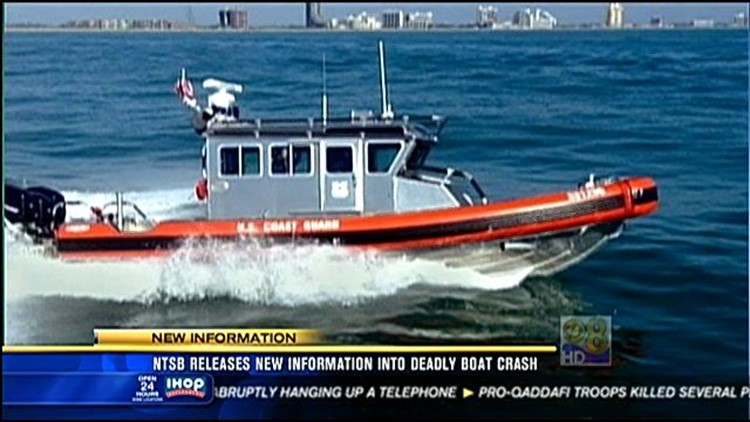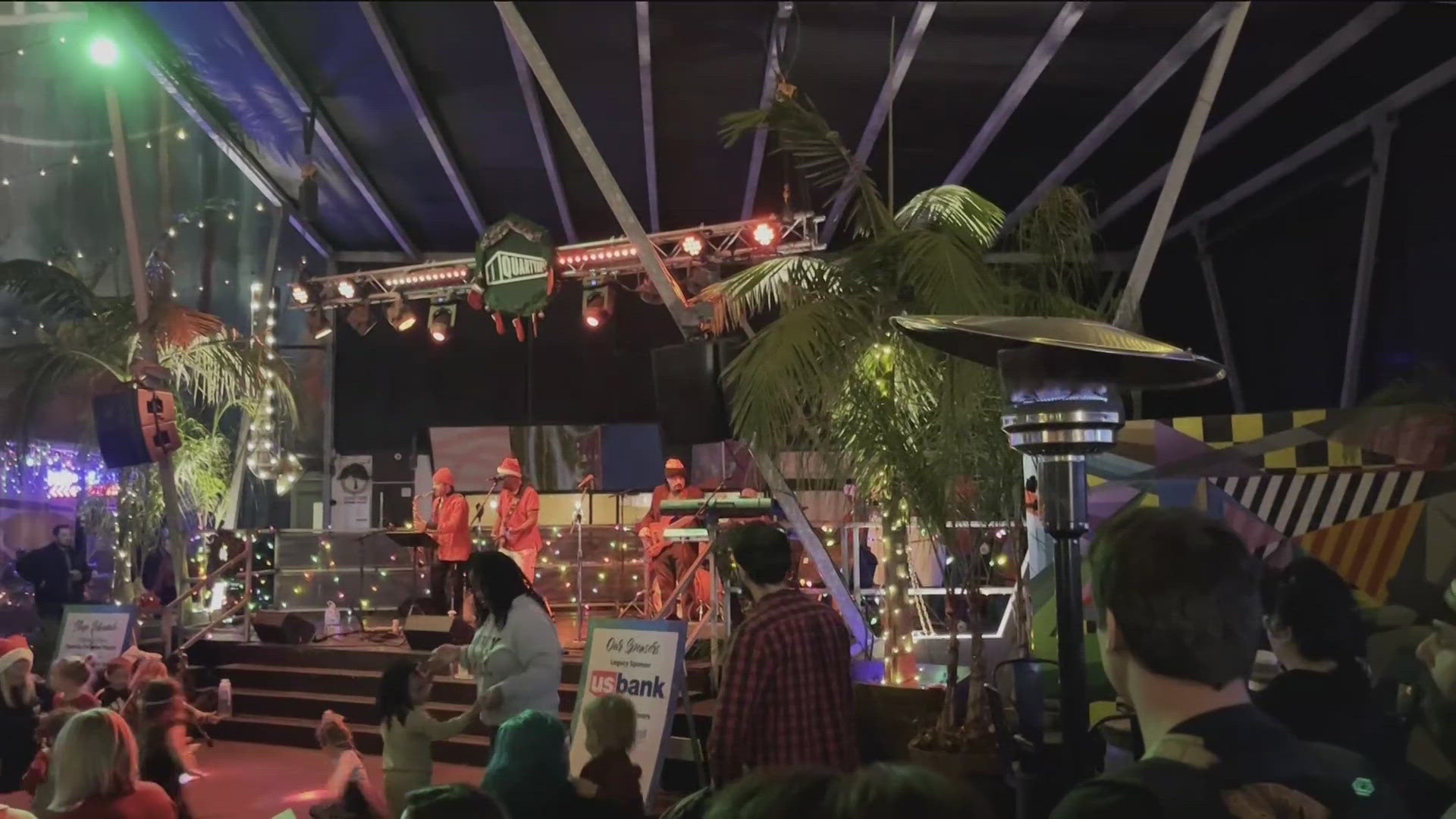SAN DIEGO (AP) — Coast Guard crew members aboard a vessel that struck a boat and killed an 8-year-old boy during a Christmas parade told investigators they didn't see the boat before the collision and had no discussion about it, according to documents released Thursday by the National Transportation Safety Board.
Petty Officer Jarett Koelmel estimated the Coast Guard vessel was going 20 to 25 knots — 23 to 29 mph — when it hit a boat in San Diego Bay carrying three families who had just watched a fireworks display. Five other people on the boat were injured.
The Coast Guard was responding to a report of a grounded boat on the crowded bay.
Koelmel, a lookout, was toward the back of the vessel and wasn't looking at the speedometer but estimated the speed based on engine sounds. He didn't believe the boat was cruising with its bow up, only because he didn't remember holding on to the sides.
No one said anything in the moments before the crash, Koelmel recalled.
"It just occurred," he said, according to a transcript.
Petty Officer Lavelle Teague, another lookout, didn't remember the speed or if the bow was up, according to an investigator's notes. Teague said no one saw the pleasure boat.
The driver, Petty Officer Paul Ramos, and the two other crew members refused to speak with investigators, NTSB spokesman Peter Knudson said.
Tests on all five Coast Guard crew members showed no signs of drugs or alcohol in their blood or urine.
The NTSB did not assign blame or explain what went wrong in the more than 4,000 pages of interview transcripts and other documents that were released.
"It contains absolutely no new information," said Mike Neil, an attorney for the family of Anthony DeWeese, the boy who died. "Absolutely none."
Neil, who represents the family in a wrongful death lawsuit against the federal government, said he believed the 33-foot Coast Guard vessel was going too fast on Dec. 20, 2009, and its bow rises too easily when it picks up speed, blocking the driver's view.
Alan DeWeese told investigators he drove his father's 26-foot Sea Ray slowly through the bay to enjoy the spectacle of the parade with family and friends, possibly reaching 5 mph at his fastest. He looked back and saw a boat coming toward him fast, thinking it would change course.
When he looked again, he slammed the throttle forward but it was too late.
"I could tell that they had no clue that we were even in the water," DeWeese said, according to a transcript of his interview by investigators.
After the Coast Guard crashed atop his boat, DeWeese accounted for two of his children but couldn't find Anthony, who was seated in the back. He screamed, "Where's my son?"
He found Anthony face down in a pile of life jackets, "not moving, not conscious, just in a weird position." His face was covered with blood.
Ramos faces a court-martial next month on charges of involuntary manslaughter, negligent homicide and aggravated assault.
Ian Howell, the highest-ranking member of the patrol boat crew that night, faces charges of negligent homicide, assault, negligence with a boat and dereliction of duty.
Both men have pleaded not guilty.
Petty Officer Brittany Rasmussen was reprimanded but avoided time in the brig after pleading guilty to dereliction of duty in military court.
The Coast Guard dropped a charge of dereliction of duty against Teague. Koelmel was never charged.
THIS IS A STORY UPDATE . For an earlier story, please read below.
SAN DIEGO (CNS) - The federal agency investigating a Coast Guard boat accident that killed a third-grader riding in a pleasure vessel on San Diego Bay released hundreds of pages of documents in the case Thursday, including a transcript of an in-depth interview with the victim's grieving parents.
The National Transportation Safety Board made the reports and witness statements public as part of its process of determining the cause of the Dec. 20, 2009, collision between the government patrol craft and the recreational motorboat carrying 8-year-old Anthony DeWeese, his parents, brothers and eight family friends.
The group, six adults and seven children, had gone out on the harbor that evening aboard a 24-foot Sea Ray belonging to Anthony's grandfather to watch San Diego's annual "Parade of Lights," which features a fireworks show and a procession of vessels decorated for the holidays.
Anthony was pronounced dead at UCSD Medical Center shortly after the collision off the west end of Harbor Island. Four other passengers on the Sea Ray suffered serious but non-fatal injuries.
Four of the five Coast Guard personnel staffing the 33-foot patrol boat were charged by military prosecutors in connection with the accident. Two face courts-martial later this year on allegations of negligent homicide and other counts. Another pleaded guilty last month to dereliction of duty, and the fourth was cleared of all charges in November.
The involved crew members, who were on their way to help a stranded boater at the time of the collision, have stated that their patrol vessel had structural defects and claim to have been hampered in their duties by substandard training and poor leadership.
Lawsuits by the families involved in the crash contend that witnesses saw the boat traversing the bay at excessive speeds earlier on the evening of the accident.
It is unclear when the federal probe into the collision will be complete, but NTSB investigations generally last from 12 to 18 months, agency spokesman Peter Knudson said.
The materials released by the federal agency on Thursday include various accounts of conditions surrounding the fatal accident, summaries of Coast Guard operations and training policies, a variety of witness statements and a Jan. 11, 2010 interview with Anthony's parents.
During the roughly 75-minute exchange with federal investigators, Alan and Caroline DeWeese of Rancho Penasquitos described in great detail a carefree family outing shattered in an instant by shock and horror.
The DeWeeses and their friends had just watched the holiday fireworks and were cruising slowly toward the Point Loma side of Harbor Island to take in the bay parade about 5:40 that evening when they heard a high-throttled boat approaching from behind, Alan DeWeese said.
"I looked back, and I could see them off in (the) distance, coming up," he said. "And I looked back again, and they had closed on me so fast, I was like, well, you know, I'm waiting for them to change course because we weren't going - we weren't at any speed whatsoever. And when I looked back that second time, I could tell that they had no clue that we were even in the water."
Just before impact, DeWeese perceived three people illuminated by some kind of glow inside the pilothouse of the patrol vessel.
"But in that quick second, I knew that they weren't changing course," he told the government interviewers. "I just had that feeling, like, oh, my God, it's going to - we've got to move, and at that point I - I was in gear already, so I slammed the throttle forward, which (was) on my right, my starboard. I did a quick turn to the right, starboard, as fast as I could ... ."
A moment later, the Coast Guard boat hit the back of the Sea Ray, where Anthony was sitting. "And at that point, I was slammed into the console and kind of pushed down into the windshield and hit my face on either the windshield or the console," Alan DeWeese said.
He estimated that the patrol vessel was traveling at 30 to 40 knots when the crash occurred and said there was no indication the pilot had tried to slow down in the seconds prior to the collision.
"It cleared - it was not situated on top of us," he said. "It ran and jumped our boat, and then we didn't see it. It (didn't) come up and go slowly and go off the side. It was ram, push, and jumped and was gone. And we could not see it, it had such high speed. There was no just kind of cruising up to us and rolling off. ... It literally (shot) right over top of us at very high speed. ... It was like we set up a ramp for them."
At that point, DeWeese described a chaotic and confused scene, with his family and friends bloodied and sprawled in the damaged boat.
"And when I looked in the stern, there was debris all over the place, and then my son was missing," he said. "That's when we first realized that there was somebody missing, and I started looking in the water and we started looking, you know, and screaming, you know, `Where's my son? Where's my son?"'
Caroline DeWeese then recounted her panicked attempt to account for all her children.
"My oldest son, Nathan, was at the front," she said. "Dominic was in my arms. And then it's like, OK, I have three children, one, two - where's the third one? Where's the third one? One, two, where's number three? ... (Then) that horrible realization comes - is he in the water? Is he in the water? Where is he?"
Alan DeWeese then "started really looking" through the boat for Anthony, soon checking in a small below-deck area housing a lavatory.
"I pulled the door off, and somebody screamed, `There he is,' and we found my son face-down in all the life jackets, my extra life jackets ... not moving, not conscious, just in a weird position," he said. "We knew something bad (had happened)."
At some point during the commotion, a Coast Guard crew member "jumped over onto the boat," Alan DeWeese said.
"I was trying to help get my son," he said. "(The guardsman) said, `Let me handle it. Let me do my job,' (and) I was like, OK, and I separated myself. He scooped him up and just immediately took him back to his boat, and I was yelling, `Is he OK? Is he breathing? Is he alive?' And he said, `Yeah, he has a pulse.' ... Then they left.
"They didn't say stay here, they didn't send somebody else onto the boat to help with the victims. They left, and they didn't say there was another boat coming to help. There was nothing said."
Alan DeWeese said he eventually was able to flag down a tow boat, which took the three traumatized families to a dock near Bali Hai restaurant on Shelter Island.
Growing increasingly frantic, the DeWeeses were unable for a time to learn where Anthony had been taken, since emergency personnel seemed uncertain themselves.
"And then finally," Alan DeWeese said, "two police officers got their vehicles together, and I took my son Dominic, (the) youngest, and put him on my lap and got in the cruiser, and (my wife) was with my son, my oldest son, Nathan."
Caroline DeWeese said she learned of her middle son's death shortly thereafter - from a computer terminal in the squad car.
"There's a screen in a police car that tells you the incidents that are going on that day. ... So I knew my son was dead that moment," she told the NTSB investigators. "And I said, `Sir, could you please find another screen? You need to shut the screen.' ... And I remember asking him, `What day is today?' `December 20th, ma'am.' And I knew that December 20th was going to be the day that he had died."



